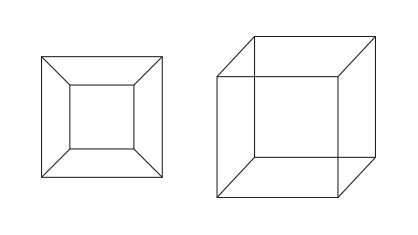Ovo wrote:Hey it's me again.

Not at all, this is not a perspective or orthogonal projection of a tesseract. It's a self-wrapping 3D map of the surface of a tesseract. As the title of the video says too, you are exploring just the surface of the tesseract. The POV is
in the surface. As if, by analogy with exploring the surface of a cube, the POV was in the faces, looking straight at the edges with a 1D display.
The video underscores that point that 3d subspace of 4D feels the same as our homey 3D. When you get into it, it does not look flat at all.
Ovo wrote:The eight cubes face to face constitute a surface with zero 'hyperdepth' enclosing a 4D space.
Yes, supposedly. While our router still worked, I spent whole night looking for cross sections of tesseract or simplex, or any 4d object. Hoping to see an arrow pointing at its middle with caption: here is where the 4d bulk lives. Everyone shows fancy projections and no one wants to do a boring cross-section through the middle of a tesseract to show its bulk.
If you see such a cross-section of tesseract or simplex, please let me know.
In 3D, the analogy is to cut a cube in the middle. If the cutting plane II to a pair of faces, we get a boring square. Just like a face of the same cube. Except that the edges of this square represent the cube's faces and its area is a section of 3d volume. That's where volume of a cube lives. Why no-one does the same for a 4-cube? Or a simplex? I want to see such a cross-section.
Ovo wrote:This is entirely different from planes in 3D. No matter how many planes we stack on top of each other in 3D, they still will amount to 0 thickness. But stacking 3d things in 4D, apparently, can make up a 4d object?
A cube is flat in 4D, it has zero length on the W axis. Stacking cubes doesn't fill up a 4D space. It's the same as stacking squares in 3D.
See, here you're mistaken. That's where 4D is vastly different from 3D. Because you
can break up a 4D space into 4 3d subspaces. So, take a tesseract and place its vertex at the origin of 4 axes. (It's like putting a cube's vertex at (0,0,0); thus its 3 adjacent faces coincide with XY, XZ and YZ planes.) With the tesseract the result is this: XYZ, XYW, XZW, YZW. Now, the difference with 3D is that you can put a cube into each of those 4 subspaces, and
they will fill in the bulk. Because you will orient the additional cubes in the
4th direction.
It's like the 8 cubes of tesseract. The 8 cubes can be stacked in 3D or the same cubes can be stacked in 4D.
Draw a 4D graph. And break it into 4 3d subspaces for your convenience. (instead of drawing I recommend 4 corners of real boxes representing 3 planes; label them). Play with these real 3d subspaces and try to imagine all 4 of them fitting perfectly. Alas, not possible in 3D, but you can examine each pair of 3d subspaces separately, where their planes coinside, say XYZ and XYW are adjacent at XY plane. You realize that there is a cube sitting in each of subspaces: XYZ, XYW, XZW, YZW, with its vertex pointing at the origin of the XYZW axes.
The faces of all those 4 cubes are adjacent in 4D and they are stacked continuously. That's because volume IS a volume. But area is not volume. And even though, granted, 3-volume is not the same as 4-volume, and mathematically in both cases, going 2D->3D or 3D->4D it's just another power, but the result is not the same. You can stack n-volumes and they will make up (n+1) volumes for n>2. You simply stack them into the n+1 direction.
Ovo wrote:Area and volume are such different things... they are not compatible.
The area is the 2D analog of the length of a 1D object and of the volume of a 3D object. They are the same thing in a different n-dimensional space, they have analog properties.
Here you are too quick to draw wrong conclusions. I am off in search of a theorem that n-volumes can add to (n+1) volumes for n > 2.
Ovo wrote:The 8 cubes that bound it on 8 sides have their edges aligned in 4D. There is no space in between them.
Really, get this idea out of your head.
Show me where the bulk lives. If it is there, you can do a cross-section of a tesseract to demonstrate it.












